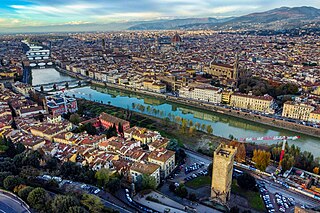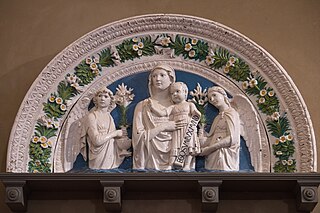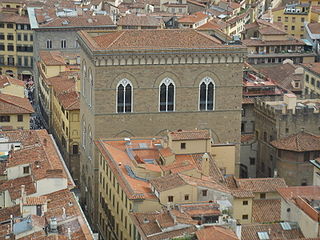
Florence is the capital city of the Italian region of Tuscany. It is also the most populated city in Tuscany, with 360,930 inhabitants in 2023, and 984,991 in its metropolitan area.

The Uffizi Gallery is a prominent art museum located adjacent to the Piazza della Signoria in the Historic Centre of Florence in the region of Tuscany, Italy. One of the most important Italian museums and the most visited, it is also one of the largest and best-known in the world and holds a collection of priceless works, particularly from the period of the Italian Renaissance.

Filippo di ser Brunellesco di Lippo Lapi, commonly known as Filippo Brunelleschi and also nicknamed Pippo by Leon Battista Alberti, was an Italian architect, designer, goldsmith and sculptor. He is considered to be a founding father of Renaissance architecture. He is recognized as the first modern engineer, planner, and sole construction supervisor. In 1421, Brunelleschi became the first person to receive a patent in the Western world. He is most famous for designing the dome of the Florence Cathedral, and for the mathematical technique of linear perspective in art which governed pictorial depictions of space until the late 19th century and influenced the rise of modern science. His accomplishments also include other architectural works, sculpture, mathematics, engineering, and ship design. Most surviving works can be found in Florence.

Luca della Robbia was an Italian Renaissance sculptor from Florence. Della Robbia is noted for his colorful, tin-glazed terracotta statuary, a technique that he invented and passed on to his nephew Andrea della Robbia and great-nephews Giovanni della Robbia and Girolamo della Robbia. Although a leading sculptor in stone, after developing his technique in the early 1440s he worked primarily in terracotta. His large workshop produced both less expensive works cast from molds in multiple versions, and more expensive one-off individually modeled pieces.

Stonemasonry or stonecraft is the creation of buildings, structures, and sculpture using stone as the primary material. Stonemasonry is the craft of shaping and arranging stones, often together with mortar and even the ancient lime mortar, to wall or cover formed structures.

Orsanmichele is a church in the Italian city of Florence. The building was constructed on the site of the kitchen garden of the monastery of San Michele which no longer exists.

Florence Cathedral, formally the Cathedral of Saint Mary of the Flower, is the cathedral of Florence, Italy. It was begun in 1296 in the Gothic style to a design of Arnolfo di Cambio and was structurally completed by 1436, with the dome engineered by Filippo Brunelleschi. The exterior of the basilica is faced with polychrome marble panels in various shades of green and pink, bordered by white, and has an elaborate 19th-century Gothic Revival façade by Emilio De Fabris.

Bernardo di Matteo del Borra Gamberelli (1409–1464), better known as Bernardo Rossellino, was an Italian Renaissance sculptor and architect, the elder brother of the sculptor Antonio Rossellino. As a member of the second generation of Renaissance artists, he helped to further define and popularize the revolution in artistic approach that characterized the new age. His work is often hard to distinguish from that of his brothers working in the family workshop.

The Accademia di Belle Arti di Firenze is the oldest public institution of fine arts training in the world. Founded in 1563 by Cosimo I de' Medici under the influence of Giorgio Vasari, it was subsequently reorganized at the initiative of the Grand Duke of Tuscany and separated from the Accademia delle Arti del Disegno in 1784. Michelangelo, Benvenuto Cellini and other significant artists have been associated with it. Like other state art academies in Italy, it became an autonomous degree-awarding institution under law no. 508 dated 21 December 1999, and falls under the administration of the Ministero dell'Istruzione, dell'Università e della Ricerca, the Italian ministry of education and research. The adjacent Galleria dell'Accademia houses the original David by Michelangelo.

Michelozzo di Bartolomeo Michelozzi was an Italian architect and sculptor. Considered one of the great pioneers of architecture during the Renaissance, Michelozzo was a favored Medici architect who was extensively employed by Cosimo de' Medici. He was a pupil of Lorenzo Ghiberti in his early years, and later collaborated with Donatello.

The Ciompi Revolt was a rebellion among unrepresented labourers which occurred in the Republic of Florence in Tuscany, Italy, from 1378 to 1382. Those who revolted consisted of artisans, labourers, and craftsmen who did not belong to any guilds and were therefore unable to participate in the Florentine government. These labourers had grown increasingly resentful over the established patrician oligarchy. In addition, they were expected to pay heavy taxes which they could not afford, forcing some to abandon their homes. The resulting insurrection over such tensions led to the creation of a government composed of wool workers and other disenfranchised workers which lasted for three and a half years.

The Four Crowned Martyrs or Four Holy Crowned Ones were nine individuals who are venerated as martyrs and saints of Early Christianity. The nine saints are divided into two groups:
- Severus, Severian(us), Carpophorus (Carpoforus), Victorinus
- Claudius, Castorius, Symphorian (Simpronian), Nicostratus, and Simplicius

The Arte della Lana was the wool guild of Florence during the Late Middle Ages and in the Renaissance. It was one of the seven Arti Maggiori ("greater trades") of Florence, separate from the Arti Minori and the Arti Mediane (the "middle trades"). The Arte della Lana dealt in woollen cloth and cooperated with the other corporations of bankers and merchants in administering the commune, both under the podestà and the Republic of Florence. The powerful Albizzi family were prominent members of the guild.

The Ospedale degli Innocenti 'Hospital of the Innocents', also known in old Tuscan dialect as the Spedale degli Innocenti, is a historic building in Florence, Italy. It was designed by Filippo Brunelleschi, who received the commission in 1419 from the Arte della Seta. It was originally a children's orphanage. It is regarded as a notable example of early Italian Renaissance architecture. The hospital, which features a nine bay loggia facing the Piazza SS. Annunziata, was built and managed by the "Arte della Seta" or Silk Guild of Florence. That guild was one of the wealthiest in the city and, like most guilds, took upon itself philanthropic duties.

Niccolò di Pietro Gerini was an Italian painter of the late Gothic period, active mainly in his native Florence although he also carried out commissions in Pisa and Prato. He was not an innovative painter but relied on traditional compositions in which he placed his figures in a stiff and dramatic movement.

Italian Gothic has characteristics that distinguish it considerably from that of the place of origin of Gothic architecture, namely France, and from other European countries in which this language has spread.

Bicci di Lorenzo (1373–1452) was an Italian painter and sculptor, active in Florence.

The guilds of Florence were secular corporations that controlled the arts and trades in Florence from the twelfth into the sixteenth century. These Arti included seven major guilds, five middle guilds and nine minor guilds. Their rigorous quality control and the political role in the commune that the Arti Maggiori assumed were formative influences in the history of Florence, which became one of the richest cities of late medieval Europe.

The Accademia delle Arti del Disegno is an academy of artists in Florence, in Italy. It was founded on 13 January 1563 by Cosimo I de' Medici, under the influence of Giorgio Vasari. It was initially known as the Accademia e Compagnia delle Arti del Disegno and consisted of two parts: the company was a kind of guild for all working artists, while the academy was for more eminent artistic figures of the Medici court, and supervised artistic production in the Duchy of Florence.

The Palazzo dell'Arte dei Beccai or Residenza dell'Arte dei Beccai is a fourteenth-century building in Florence, Italy. It faces the Orsanmichele, once a grain market, later the church of the guilds of Florence. It has had many occupants, including the Arte dei Beccai or guild of butchers from which its name derives. Since 1974 it has housed the Accademia Fiorentina delle Arti del Disegno, an academy of the arts.



















